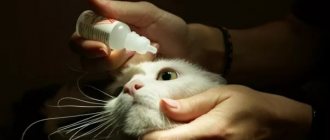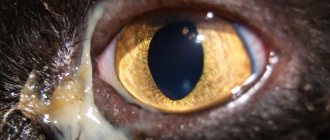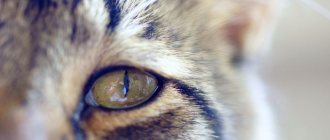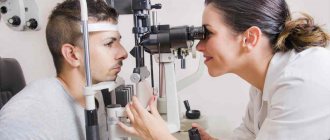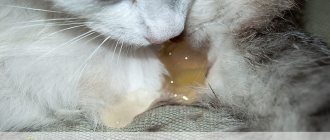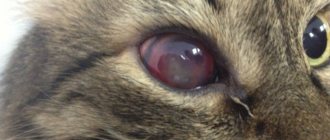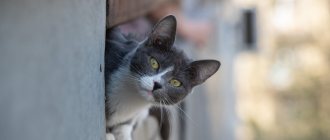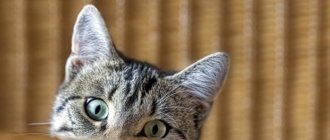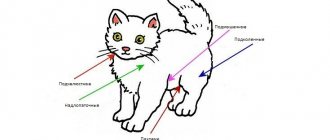Taking care of our pets is the least we can repay them for their devotion and selfless love. Everyone who has a cat in their home is concerned about its well-being and health, because the animal itself cannot tell us where and what hurts. Therefore, the longevity of your pet lies entirely on your shoulders, it is your responsibility.
If you notice that your cat's eyes are running, changes in her behavior, it seems to you that she is lethargic, has a poor appetite and shows apathy towards the world around her, then you should take a closer look at her. Is this a serious illness or a temporary phenomenon? Do you need to urgently run to the veterinarian or is what is happening to your pet a normal natural process that has nothing to do with potential illnesses? We will discuss what to do and how to alleviate your pet’s condition further.
Symptoms - how to understand that your cat is sick.
There are many unpleasant diseases that can affect your pet's vision. It is important to recognize them in time and seek qualified help, because the lack of treatment or untimely intervention by a specialist will aggravate the situation and even lead to complete or partial loss of the pet’s vision.
You should be seriously concerned about the condition of your furry friend if you notice the following symptoms:.
- Brown discharge from a cat's eyes, often mixed with pus, indicates the presence of a bacterial infection in the animal's body. Additional symptoms in this case may include lethargy and nasal discharge.
- Clear discharge, as well as abundant and thick discharge, warns you of a viral infection.
- Brown discharge most often appears when the tear ducts malfunction.
- If a cat has swollen eyes and waters with ordinary tears, without any admixture of pus, but in large quantities, she sneezes and itches, then most likely this is an allergic reaction. This disease is also heralded by redness of the eyelids and their swelling.
- Reddish discharge from the eyes can easily be confused with brown if the cat has a dark fur color.
- Watch his reaction to others - is the cat making contact or has he become unsociable?
- Has his appetite changed?
- Check for scratches and other mechanical damage near the eyes.
- Try to find out what color the discharge from the pet’s eyes is, and whether there is any admixture of pus in it.
Perhaps they are not so pronounced, and it is difficult for you to decide what exactly is bothering your pet. In this case, it is worth observing his behavior.
If all these symptoms are absent in your case, and the cat’s eyes are watering with ordinary transparent tears, then there is no reason to panic. There are a number of reasons why even a healthy animal can have watery eyes. This is an unsuitable diet, characteristics of the breed, an allergic reaction to certain components or substances.
Causes of discharge
Exudate from the eyes is characteristic of several ophthalmological diseases:
- Inflammation of the mucous wall of the eye - conjunctivitis . The disease manifests itself as redness of the conjunctiva, sometimes they become red with a brown or bluish tint. Conjunctivitis also causes photophobia, itching in the eye sockets, and profuse mucous or purulent discharge from the eyes. In this case, the conjunctival mucosa has varying degrees of damage (wounds or ulcers).
- Increased production of tears - epiphora . This pathology is usually the result of an allergy to some irritant or an instinctive reaction aimed at the speedy elimination of a foreign body that has penetrated the visual organ. In pathological cases, epiphora occurs when the lacrimal duct is obstructed.
- Inflammation of the choroid of the eye - uveitis . The disease develops as a result of various infectious and/or invasive infections and is characterized by discharges of different consistency and color.
- Inflammation of the cornea - keratitis . Viscous yellowish or greenish discharge is indicative of it. At the same time, the eyes run, the eyelids often stick together and become overgrown with crusts.
Why a cat's eyes are running - possible reasons.
An ordinary healthy cat always secretes a clear liquid secretion from the organs of vision, but it is almost unnoticeable. Those rare cases when a pet exhibits profuse lacrimation are also considered normal. This happens due to the negative influence of external factors such as smoke, dust, harsh lighting or caustic chemicals, and poor hygiene. As a rule, after the cat returns to its normal environment without external stimuli, the production of tears stops.
You should be concerned when a cat develops dark discharge from the eyes, as this is direct evidence of the presence of an infection in the animal’s body. If you notice cloudy, brown, white or red discharge from your pet, immediately seek help from a specialist and do not try to treat the animal yourself at home.
If there is a bacterial infection in the animal’s body, not a viral one, you will notice discharge from the eyes that differs from tears. They can also be white or yellowish in color and cause inflammation in the area.
There are a number of diseases that can cause disruption of the tear ducts in cats:
- This is the formation of tumors and neoplasms that compress the channels.
- Allergy to external irritants or food. This reason is one of the most common.
- Non-infectious inflammation of the lacrimal sac.
- Physical trauma to the eyes.
- A foreign object that has entered the lumen of the lacrimal canal.
- Stenosis of lacrimal openings.
- Narrowing of the tear ducts due to inflammatory processes in the body.
- Infectious conjunctivitis.
- Inflammation of the eyelids.
- Incorrect growth of eyelashes (trichiasis).
- Damage to the cornea.
- Disease of the eye vessels.
- Glaucoma.
- Breed predisposition. Some cat breeds, such as Persian or British, have a brachycephalic skull structure, which causes them to have a shortened tear duct and increased tear production.
- Helminthic infestations.
- Immunity problems. It is most common in kittens and older cats who often have colds, causing them to have excessive watery eyes.
Do not forget that whatever the cause of the disease, prolonged absence of proper treatment will worsen the situation. All this time the animal will experience discomfort. As a result, the cat will begin to scratch the sore eye, scratching it into wounds and increasing the area of infection with microbes.
Normal eye discharge
In most cases, cats have slightly wet, shiny eyes. The lacrimal glands secrete secretions to moisturize the mucous membranes. This helps clean the outside, prevents drying out and provides some protection from damage. Cats' eyes do not normally run, but they may release a small amount of fluid when they encounter irritants. Bright light, dust, wind or cigarette smoke can act as a provocateur.
Periodic lacrimation is observed in brachycephalics. In cats with flattened faces, the functioning of the glands and the outflow of fluid are disrupted after a long stay in a horizontal position or on the side. Animals with large bulging eyes are more susceptible to infectious inflammation and external factors, since their organs are less protected by skin folds. The risk group includes Persian and Scottish cats, exotics, bobtails, etc. Representatives of these breeds and mestizos, which have inherited specific traits, require careful care and removal of discharge.
Treating a cat at home.
In order to decide how to treat your pet at home and not cause further damage to it, be sure to first consult with a veterinarian. After the necessary tests and a thorough examination, your cat may be prescribed antibacterial or antiviral treatment, as well as drops, antibiotics or special anti-inflammatory ointments. In some cases, the animal is prescribed physical therapy or surgery.
If your cat has constant excessive tearing and there are scabs in the corners of the eyes, or the cat has swollen eyelids, dark discharge with an unpleasant odor, or blurred vision, then you should take her to a specialist. Pay attention to the pet's body temperature and general condition. Fever, lethargy, depression, sneezing, and refusal to feed are all symptoms of the disease that require detailed study.
You should also contact your veterinarian immediately if your cat has a foreign object in its eye. Under no circumstances try to remove it yourself, as without special tools and the necessary skills you will injure the animal.
You don't have to wait to see a specialist and have a positive impact on your cat's well-being. But keep in mind, the following tips will not cure your pet, but will only temporarily and partially alleviate his suffering until the cat is examined by a veterinarian and the appropriate treatment is prescribed.
Treatment of the disease
If you have a question about how to treat your cat, you need to contact the clinic. The doctor will examine and interview the animal owner. Fluid may be collected from the tear glands for testing. This allows you to identify the strain of bacteria and select an effective drug. Depending on the causes of the disease, anti-inflammatory drugs and antibiotics can be used. In advanced cases, surgery is performed. Surgery may involve removing the eye, widening the tear ducts, removing a foreign object, etc.
If visiting a veterinarian is not possible, you can administer first aid to improve the condition yourself. It is recommended to use chamomile decoction for rinsing. It is prepared from pharmaceutical raw materials and distilled water. It is important to use clean liquid, otherwise the eye may become infected.
For rinsing you will need a cotton pad. It is recommended not to use gauze or standard cotton wool, as particles may remain on the surface. Rough fabric can damage delicate mucous membranes. A cotton pad is moistened in the liquid and gently wiped from the inner corner to the outer corner. If there are crusts, do not roughly remove them. You should soak the accumulations, then try to carefully remove them.
Both eyes need to be treated. A separate swab is used for each to prevent transmission of infection. It is allowed to use antibacterial solutions for treatment after permission from a veterinarian.
How to wash a cat's eyes at home?
Suitable herbal infusions of chamomile, oak bark, and saline solution will help your cat cope with the disease before being examined by a doctor. You can also wash her eyes with an alcohol-free antiseptic solution.
You need to wash your cat's eyes with a cotton swab, from the outer edge to the inner. This must be done very carefully and gently so as not to harm the pet and cause him a minimum of discomfort.
Discharge from the eyes and nose is also treated with special ointments. In some cases, the cat needs to pull back the lower eyelid and put ointment there, for example, tetracycline ointment, novocaine, hydrocartisone drops, levomecitin drops. Keep in mind that it is not recommended to use antibiotics and ointments on your own without a veterinarian's prescription.
Owner's first aid
Of course, when a cat has suppuration, a veterinarian’s consultation is necessary. Only after an examination can a veterinarian make an accurate diagnosis and prescribe appropriate treatment. However, the owner must also be able to provide first aid carried out at home. First of all, rinsing is necessary.
Eye wash
How can you wash your eyes?
- Decoction of chamomile flowers.
- Boric acid solution (2 teaspoons of medicine per half liter of warm boiled water).
- 0.02% solution of furatsilin.
Rinsing is best done together, one person should hold the animal and the other should carry out the procedure, this is necessary so as not to damage the pet’s eyes.
How to wash?
The basic rule: the solution must be warm, you cannot use it hot so that the animal does not get burned. A cotton pad, previously twisted into a tourniquet, is dipped into the medicine, which is then squeezed onto the cat’s diseased organ. You need to wash until all the pus is removed. After each wash, the cotton pads should be changed; it is best if the tourniquet is disposable.
You cannot use dry cotton wool, as it can further injure the eye. You should not replace a cotton pad with cotton swabs. Of course, they are more convenient to use, but the sticks pick up a small amount of solution. After you have finished rinsing, you need to put 1% Tetracycline ointment behind the eyelid.
We use ointment
How to apply ointment correctly?
Before applying the ointment, it must be warmed in your hands; there is no need to make investments with a cold composition:
- One person holds the cat tightly, lying on his side.
- The other, meanwhile, carefully pulls back the animal's lower eyelid.
- Use a special spatula to apply ointment to the lower eyelid.
- Then you need to close the eye and distribute the ointment with light massaging movements.
We use drops
What drops can be used to bury a cat?
In order to treat a cat, you can use different drops, for example, Levomycetin, Sodium Sulfacyl, Diamond Eyes drops.
How to carry out the procedure correctly?
- The cat needs to be laid on its side, and in such a way that the eyeball is directed upward.
- In order to administer the drops, you need to hold your pet firmly so that it does not get injured.
- Drop the medicine, after which the cat will blink vigorously, and the medicine will be distributed in the eyeball.
- Then blot the area with a napkin.
A cat's eyes are festering - how to treat it?
White discharge from the eyes, as well as watery and clear discharge, usually indicates an allergic reaction. Suitable eye drops, rinsing with solutions and using ointments will help you overcome it. It is imperative to determine the cause of the allergy, because without eliminating the original source of the disease, there is no point in dealing with the symptoms. If you notice bloody discharge, then this may indicate the presence of an infection in the pet’s body, or a violation of the patency of the tear ducts. In both cases, only veterinarian advice and a thorough examination will help. Home treatment without prior consultation with a specialist is highly not recommended.
Black discharge from the eyes occurs with infections, chlamydia and herpesvirus. Sometimes they occur due to ordinary injuries and have a shade close to brown. These discharges themselves are extremely dangerous, because apart from them there may be no symptoms. In any case, you need to visit a specialist for an examination and a course of treatment. Most often, antibacterial eye drops, solutions of chamomile infusion or strong tea are used. Rinsing with warm water will also work. Black discharge is removed with saline solution.
Since there are many reasons for the appearance of discharge from the eyes in cats, it is better not to do home treatment without visiting a doctor.
Trust the professionals and give your pet a long and happy life. An experienced veterinarian will not only determine the source of the disease and prescribe an appropriate course of treatment, but will also share with you valuable recommendations to prevent similar problems in the future. Your cat will certainly appreciate such a reverent attitude and will be grateful for the attention, care and kindness. Addresses of clinics Make an appointment with a doctor Prices
Why is the formation of fungus in the maxillary sinus dangerous?
How can the growth of a fungal colony be dangerous? In any case, it’s not very pleasant when some kind of parasite, mold, or fungus lives in you. This is really a parasite that lives in the cavity of the maxillary sinus and feels great there. In addition, mycetoma is dangerous because the blood supply and oxygen supply to the brain deteriorates, since the function of nasal breathing is disrupted. A person simply begins to experience partial oxygen starvation due to mycetoma.
Plus, the waste products of the fungus in the maxillary sinus flow into the nasopharynx, which can additionally lead to additional complications, including the development of allergies and provoking respiratory diseases. And, of course, chronic sinusitis.
The role of CT in the study of mycetoma
Of course, a good computed tomogram gives a complete picture of the maxillary sinuses and is the main tool in diagnosing “mycetoma” when examining a patient. A CT scan of the maxillary sinus shows the location, size, and volume of mycetoma damage (local volume or total fungal infection of the cavity).
In fact, computed tomography is the gold standard for diagnosing mycetoma today.
Prevention
By nature, a cat is capable of independently caring for itself and its health. If your pet leads a clean lifestyle, and his eyes begin to become inflamed, then the source of the infection is in your home. The exception is when the animal has free access to the street.
In any case, if there are animals in the house, frequent and thorough cleaning is necessary to avoid introducing infection into the body of your pets.
If for some reason the cat is not able to clean its eyes and face on its own, then this concern falls on your shoulders. Veterinary stores sell special lotions to clean the eyes of animals. They need to be used daily.
A real owner takes great care of his pets. He takes them to all the necessary vaccinations, prevents various diseases and monitors the cleanliness of the house.
Follow our advice, and your pets will have excellent health!
This article has been checked and approved by a veterinarian. Knyazeva Anna Vladimirovna, veterinarian in private practice, Moscow. more about the expert.
(you can vote for the article)
Tags: cat discharge, cat health, cat
- Related Posts
- Yorkie dog breed. Types of Yorkies
- What to feed a pregnant cat? What food is suitable?
- 16 tips from a psychologist on how to survive death or the loss of a cat
How can mycetoma be cured?
Is it possible to do without surgery? It is impossible to get rid of fungus in the maxillary sinus without surgical intervention, I will say this right away. No pills, no drops of “dancing with a tambourine” and everything else will give the desired therapeutic effect. First of all, it is necessary to surgically remove the fungal body, remove this mycelium, remove all the fungus from the maxillary sinus.
This can be done either through a nasal surgical approach or an intraoral approach.
How to remove fungus from the maxillary sinus
With intraoral access, a perforation is made in the vestibular wall of the maxillary sinus - access, and evacuation occurs through this hole, i.e. removal of the fungal body, mushroom mycelium. Then the maxillary sinus is well washed, treated with antifungal and antimicrobial drugs and sutured. Subsequently, the patient is prescribed antifungal therapy.
Surgical removal of mycetoma shows good results today, relapses are extremely rare.
